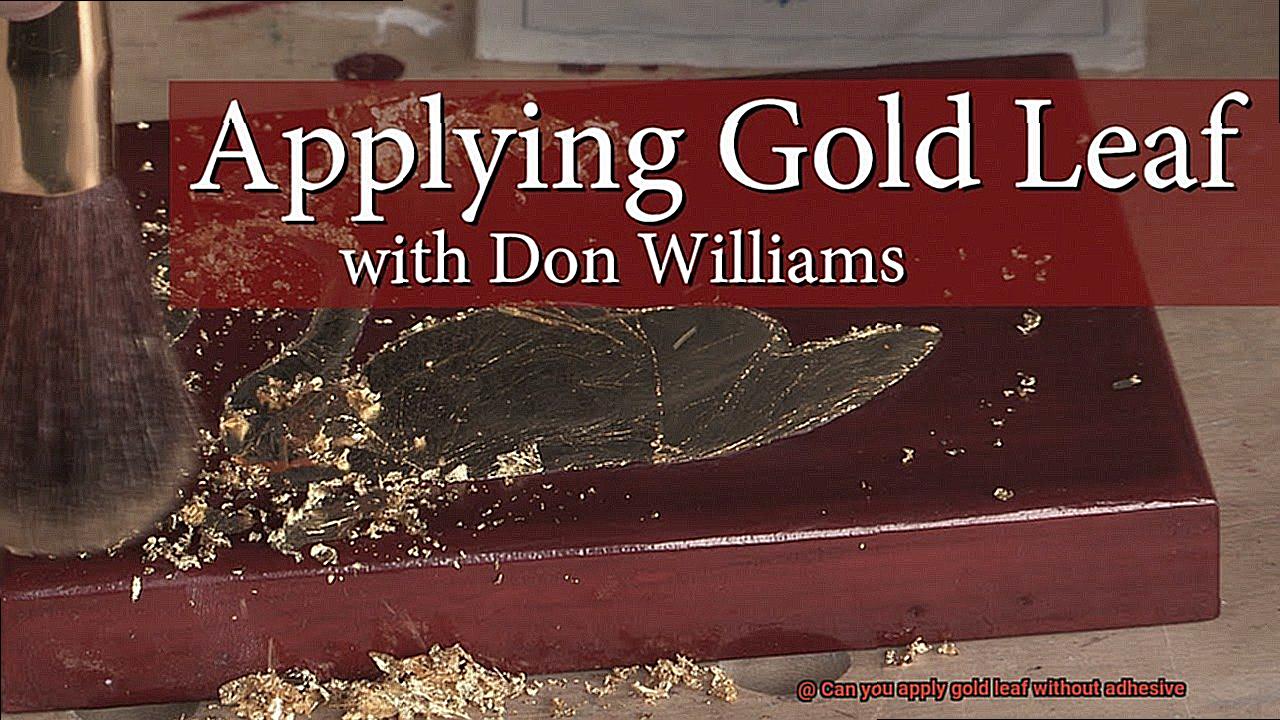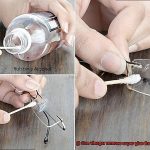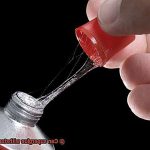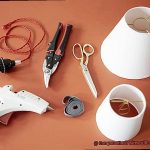It’s the stuff dreams are made of – shimmering, luxurious, and oh-so-fancy. We’ve all marveled at the masterpieces it has adorned throughout history, from majestic murals to dazzling frames. But here’s a question that might make you do a double take: Can you actually apply gold leaf without using any adhesive?
In this blog post, we’re diving headfirst into the captivating world of gold leaf application. We’ll explore whether it’s possible to achieve that gilded perfection without relying on sticky substances. Sure, in the past, glues and gilding size have been the go-to for sticking those delicate flakes in place. But guess what? There are alternative methods that can give you jaw-dropping results without any need for adhesive.

So, get ready for an artistic adventure like no other as we uncover the secrets behind adhesive-free gold leaf application. Together, we’ll embark on a journey filled with shimmering possibilities and discover just how far our creativity can take us.
What is Gold Leaf?
Contents
- 1 What is Gold Leaf?
- 2 Adhesive-Based Methods for Applying Gold Leaf
- 3 Water Gilding: An Alternative Method for Applying Gold Leaf without Adhesive
- 4 Preparing the Surface for Water Gilding
- 5 Applying the Gold Leaf with Water Gilding
- 6 Pros and Cons of Applying Gold Leaf without Adhesive Using Water Gilding
- 7 Other Alternative Methods for Applying Gold Leaf without Adhesive
- 8 Conclusion
Gold leaf is a stunningly beautiful and delicate sheet made from real gold. It is like a magical veil of shimmering brilliance that has the power to transform any surface into a work of art. To create gold leaf, artisans painstakingly hammer gold into incredibly thin sheets, which are usually around 1/250,000th of an inch thick. That’s thinner than a human hair.
Throughout history, gold leaf has been treasured and admired for its opulence and prestige. It can be found in ancient Egyptian tombs, where it adorned sacred objects and pharaohs’ burial masks. It graced the pages of medieval illuminated manuscripts, bringing illumination to the words of scribes and illuminators alike. And it was used by Renaissance painters to add a touch of radiant splendor to their masterpieces.
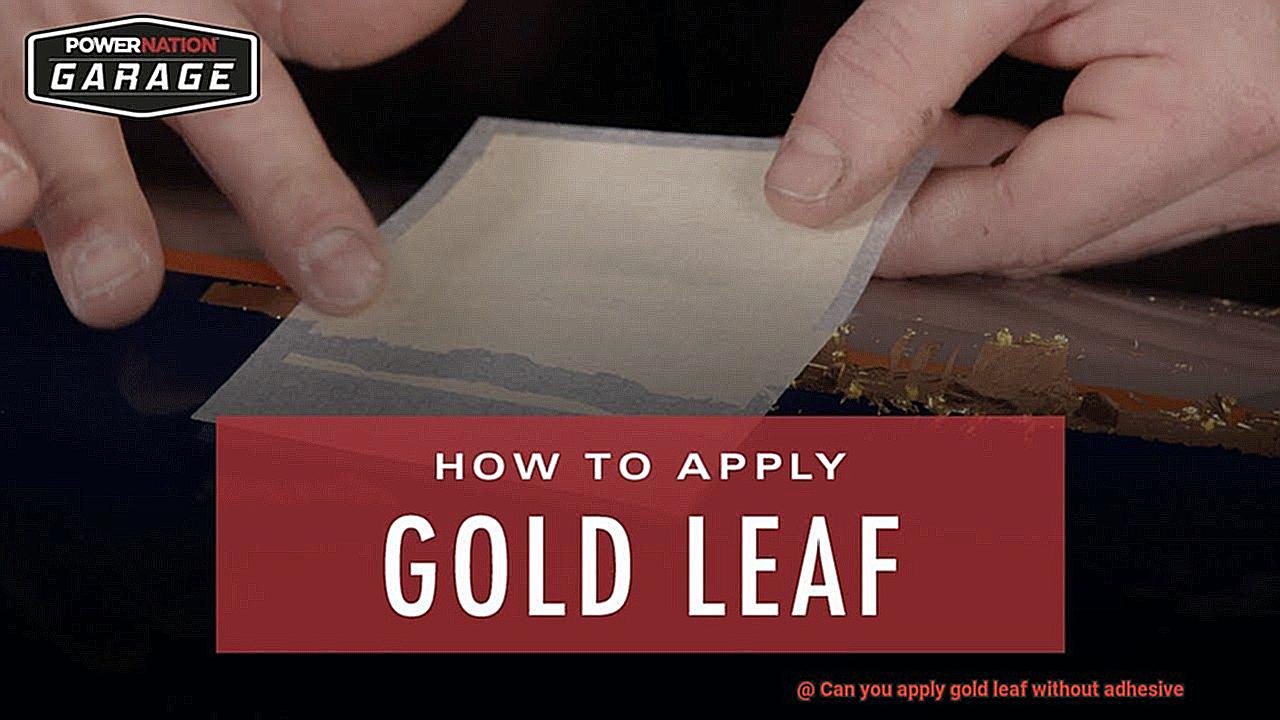
When working with gold leaf, it’s crucial to handle it with utmost care. The sheets are so fragile that even the gentlest breeze or touch can cause them to tear. That’s why applying gold leaf requires precision and patience.
There are different types of gold leaf available. The most common is “genuine gold leaf” or “pure gold leaf,” which is made entirely of gold. However, there are also variations such as “imitation gold leaf” or “composite gold leaf” that contain a mixture of metals coated with a thin layer of gold. These variations offer a more affordable option while still providing the captivating gleam of real gold.
To adhere gold leaf to a surface, an adhesive or size is used. Traditional adhesives include gilding size made from rabbit skin glue or gelatin. These adhesives not only secure the delicate sheets but also ensure their longevity, preventing them from shifting or peeling over time.
While some skilled craftsmen may attempt to apply gold leaf without adhesive using techniques like water gilding, these methods require specialized skills, materials, and tools. Adhesive-based methods are more commonly used due to their reliability and durability.
Adhesive-Based Methods for Applying Gold Leaf
Adhesive-based methods are the most common and efficient way to apply gold leaf, offering a strong bond that ensures long-lasting results. When it comes to adhesive options, there are several to choose from, each with its own unique characteristics and benefits.
Water-based glues are a popular choice, especially for beginners. They are easy to work with and dry quickly, making the application process smoother and more manageable. Plus, cleaning up any excess glue is as simple as using water.
For those looking for a stronger bond or planning to apply gold leaf to outdoor surfaces or areas that may come into contact with moisture, oil-based glues like oil gilding size are the way to go. These adhesives provide a more durable bond that can withstand various environmental conditions.

In the past, gelatin glues made from animal proteins were commonly used for applying gold leaf. Although they require heating and have a longer drying time compared to other options, they still offer a viable adhesive solution for those seeking a more traditional approach.
Modern adhesive options include acrylic adhesives, which offer a strong bond and quick drying time. These adhesives are also more resistant to moisture and temperature changes, making them ideal for both indoor and outdoor applications.
Now that we have explored the different adhesive options, let’s dive into the application process itself. Before applying the adhesive, it is crucial to prepare the surface properly. This involves ensuring that the surface is clean, smooth, and free from any dust or debris that could interfere with the bonding process.
Once the surface is ready, you can begin applying the adhesive. Using a brush or roller, apply a thin layer of adhesive evenly over the surface. This step is vital in achieving a successful application of gold leaf.
Once the adhesive has reached the appropriate tackiness, usually indicated by it being slightly sticky to the touch, it’s time to carefully apply the gold leaf. Using a soft brush or cotton pad, gently press the gold leaf onto the adhesive, ensuring full coverage of the desired area.
Any excess gold leaf can be removed by gently brushing it away or using a soft cloth. It’s important to handle the gold leaf with care to avoid tearing or damaging it during this process.
After the gold leaf has been applied, allow it to fully dry before applying any additional protective coatings. This will ensure that the gold leaf adheres securely and maintains its lustrous appearance over time.
Water Gilding: An Alternative Method for Applying Gold Leaf without Adhesive
Water gilding is a centuries-old technique used in the art of gilding that offers a beautiful alternative method for applying gold leaf without adhesive. Unlike traditional adhesive-based methods, water gilding relies on water and a special type of clay called gesso to adhere the gold leaf to the surface. This technique provides several advantages over adhesive-based methods:
- Smoother and more even application: Water gilding allows for a smoother and more even application of the gold leaf. The combination of water and bole creates a strong adhesive bond that ensures the gold leaf stays firmly in place without any lumps or bumps. This results in a flawless and professional finish.
- Vibrant and reflective finish: One of the most significant advantages of water gilding is the vibrant and reflective finish it produces. Unlike adhesive-based methods, there are no layers of glue or other materials between the gold leaf and the surface. This absence enhances the true brilliance of the gold, creating a stunning visual impact.
- Durability and resistance: When done properly, water gilding can provide excellent durability and resistance over time. A layer of varnish or shellac is applied on top of the gold leaf, protecting it from tarnishing and adding an extra layer of durability. This ensures that the gilded surface retains its beauty for years to come.
- Traditional and authentic look: Water gilding offers a traditional and authentic look that is highly sought after by artists and craftsmen. This method has been used for centuries and is often preferred for restoration projects or when a traditional aesthetic is desired. The rich history and authenticity associated with water gilding add value to the finished product.
However, it is important to note that water gilding requires a certain level of skill and expertise to achieve optimal results. The process can be time-consuming and delicate, demanding careful attention to detail and precision. It is often practiced by professional gilders or experienced artists who have mastered the technique.
Preparing the Surface for Water Gilding
Preparing the surface for water gilding is not a step to be overlooked. It is the foundation upon which the entire gilding process rests, and without proper preparation, the end result may be far from satisfactory. Let’s explore the significance of surface preparation in more detail:
- Adhesion: The key to a successful gilded finish lies in ensuring that the gold leaf adheres evenly and securely to the surface. By thoroughly cleaning and smoothing the surface, any contaminants or irregularities that may hinder adhesion can be eliminated. This creates a clean canvas for the gold leaf to bond with, resulting in a seamless and durable finish.
- Aesthetics: Surface preparation is vital for achieving a visually stunning gilded finish. By addressing imperfections such as bumps or cracks and creating an even base, the gold leaf can be applied smoothly and evenly. This not only enhances the appearance but also maximizes the reflective properties of the gold leaf, adding to the overall brilliance and beauty of the gilded object.
- Durability: A properly prepared surface contributes to the longevity and durability of the gilded finish. By addressing any underlying issues such as roughness or unevenness, the gold leaf is less likely to suffer from premature wear or damage. Additionally, applying a layer of gesso as a base provides a protective barrier between the gold leaf and the substrate, further enhancing its lifespan.
- Professionalism: Surface preparation is a hallmark of professionalism and attention to detail in water gilding. Skilled artisans understand that proper preparation is essential for achieving high-quality results that meet or exceed expectations. Whether it is a restoration project or creating new gilded artwork, taking the time to prepare the surface demonstrates commitment to craftsmanship and ensures a professional outcome.
Applying the Gold Leaf with Water Gilding
Water gilding, a traditional technique used for centuries, involves applying gold leaf using water as the adhesive. This method creates a smooth and flawless finish that adds a luxurious touch to any surface. The process of water gilding consists of several steps, each playing a crucial role in achieving the desired result.

Surface Preparation:
Before applying the gold leaf, the surface must be properly prepared. This typically involves applying a base layer of gesso, a mixture of chalk and glue. The gesso creates a smooth and even surface for the gold leaf to adhere to.
Bole Application:
Once the gesso has dried, a layer of bole is applied. Bole is a clay-like material that comes in various colors, such as red, yellow, or black. The choice of bole color depends on the desired appearance of the finished gilded surface. The bole acts as a cushioning layer between the gesso and the gold leaf, providing a forgiving surface for gilding.
Drying and Burnishing:
After applying the bole layer, it needs to dry completely. Once dried, it can be burnished to create a smooth and polished surface. Burnishing involves using a tool, such as an agate stone, to compress and smooth the bole.
Gold Leaf Application:
Now comes the exciting part – applying the gold leaf. Delicately handling thin sheets of gold leaf is essential to prevent tearing or wrinkling. Using a brush or specialized gilder’s tip, water is applied to the bole surface in preparation for the gold leaf.
The gold leaf is carefully laid onto the wet bole surface, gently pressing it down with a soft brush or pad. The water acts as an adhesive, allowing the gold leaf to stick to the bole. Any excess gold leaf can be brushed away once it has adhered properly.
Drying and Burnishing:
After applying the gold leaf, it is crucial to let it dry completely. This can take several hours, or even overnight, depending on the environmental conditions. Once dry, the gold leaf can be burnished to enhance its shine and smoothness.
Pros and Cons of Applying Gold Leaf without Adhesive Using Water Gilding
Water gilding offers several advantages when applying gold leaf without adhesive. The technique provides an authentic and traditional look, favored by artisans seeking to recreate historic artworks. By using water as a medium, the gold leaf is applied directly onto the surface, resulting in a smooth and seamless finish that enhances aesthetic appeal.
Additionally, water gilding enhances the luminosity of the gold leaf. Without adhesive, more light can pass through the thin layer, creating a captivating effect. This technique is particularly effective in areas where light interacts with the gold leaf, adding depth and brilliance to architectural features or decorative objects.
Water gilding also offers versatility. Artists have more control over the application process, allowing for different effects and textures. They can manipulate the gold leaf to create intricate designs or patterns, giving their artwork a unique and personalized touch.
However, there are some drawbacks to consider when using water gilding. Firstly, the delicate finish is prone to damage without a strong adhesive bond. The gold leaf can peel or flake off if not handled with care. Protective measures, such as varnishing or sealing, may be necessary to prevent damage from moisture or physical contact.
Secondly, water gilding is a time-consuming process that requires precision and patience. The multiple steps involved can be time-consuming and require attention to detail. Artists must invest a significant amount of time and effort to achieve desired results.
Lastly, water gilding may not offer the same level of durability as adhesive-based methods. The absence of a strong bond makes it more susceptible to wear and tear over time. Environmental conditions, handling, and exposure to moisture can accelerate the deterioration of the gold leaf.
Other Alternative Methods for Applying Gold Leaf without Adhesive
In the world of gold leaf application, there are alternative methods that allow artists and craftsmen to forego the use of adhesive. One such method is water gilding, which involves applying a layer of gesso as a base for the gold leaf. Once the gesso has dried, the surface is lightly dampened with water, creating a delicate layer of moisture. The gold leaf is then carefully placed onto the damp surface and pressed down gently with a soft brush or cloth. The moisture acts as a natural adhesive, securing the gold leaf in place.
Another method is oil gilding, where oil is used as a medium to attach the gold leaf to a surface. A layer of oil-based size is applied to the surface, acting as a binding agent for the gold leaf. Once the size has reached the right tackiness, the gold leaf is applied and pressed down onto the surface. The oil-based size provides a secure bond without the need for adhesive.
For those seeking a more unconventional approach, static electricity gilding offers an intriguing option. This method utilizes an electrostatic generator to create an electric charge that attracts and holds the gold leaf onto a surface. The charged surface acts as an invisible adhesive, allowing the gold leaf to adhere effortlessly.
It’s important to note that these alternative methods may require practice and skill to achieve desired results. Each technique has its own intricacies and limitations in terms of suitable surfaces and durability. Thorough research and understanding of each method are essential before attempting them or consulting with an experienced professional.
xerAJM4kZyE” >
Conclusion
In conclusion, while there are alternative methods for applying gold leaf without adhesive, the tried-and-true approach is through adhesive-based methods. Adhesives like water-based glues, oil-based glues, gelatin glues, and acrylic adhesives create a strong bond that guarantees the longevity and resilience of the gold leaf.
Water gilding offers an intriguing alternative that relies on water and clay called gesso to secure the gold leaf. This technique delivers a smooth and flawless application, a dazzling and reflective finish, exceptional durability and resistance, as well as an authentic and traditional appearance. However, mastering water gilding demands specialized skills and expertise.
Surface preparation is paramount in both adhesive-based methods and water gilding. It ensures impeccable adhesion, enhances aesthetic appeal, improves durability, and showcases professionalism.
While options like oil gilding or static electricity gilding do exist as alternatives, they may necessitate more practice and finesse to achieve optimal results. Each method possesses its own intricacies and limitations concerning suitable surfaces and long-term durability.
Ultimately, whether you opt for adhesive-based methods or venture into alternative techniques like water gilding or others depends on your personal preferences, skill level, project requirements, and desired outcome. Whichever path you choose to tread upon, working with gold leaf is an art form that demands precision, patience, and a discerning eye for detail in order to attain that coveted state of gilded perfection.

